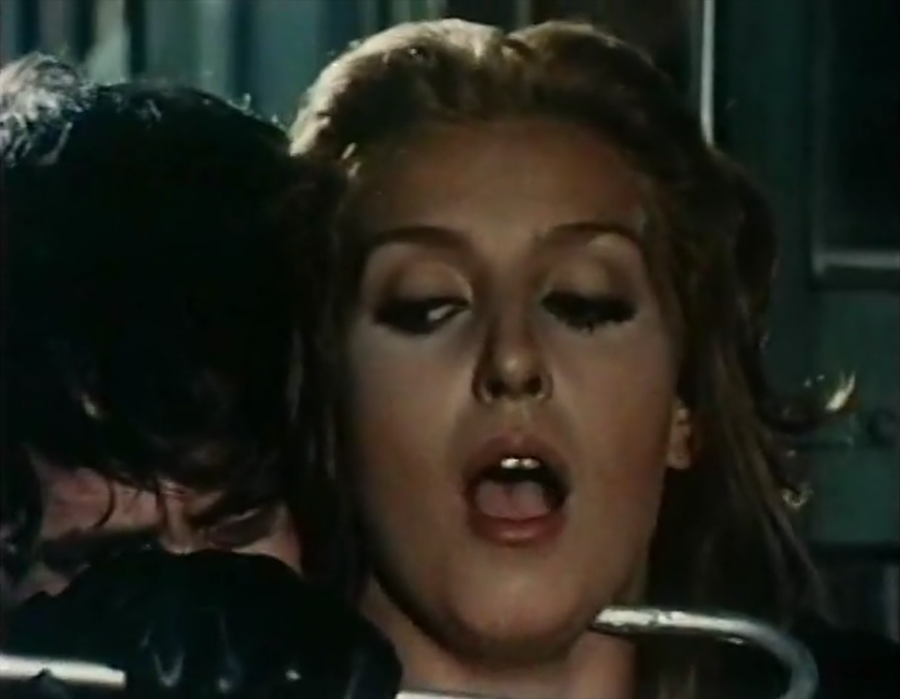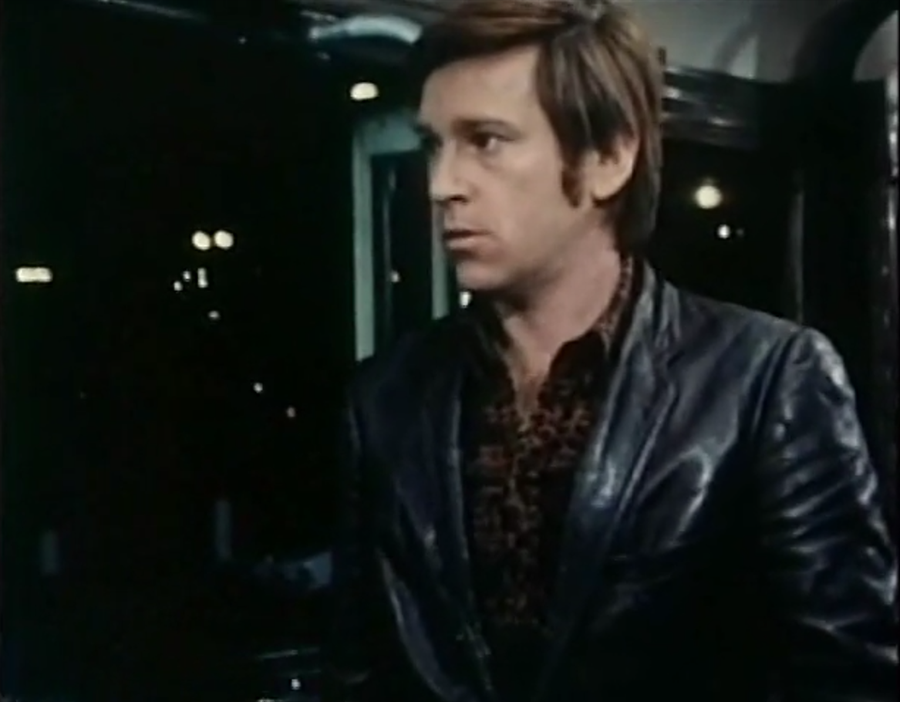THE TRAM
Directed by Dario Argento. 1973. Italy.

A young blonde has been found stabbed to death on a tram, her body stuffed under a seat. She took this tram almost every night, and always at the same time. The ticket taker and driver both recognized her. She was, after all, a regular. A dozen or so people were on the tram with her on the night of her murder, but no one saw anything odd. How could a murder take place this much in public view without anyone noticing?
This is what Inspector Franco Giordani must find out in THE TRAM, the second episode of Dario Argento’s 1973 short-lived TV series Door Into Darkness. Conceived by Salvatore Argento as a kind of Italian Alfred Hitchcock Presents, the series would bring hour-long televised giallo thrills to homes all over the country. Argento himself would be the face of the series, providing dry, clever introductions to each episode. He was, after all, the Italian Hitchcock, a nickname he earned with the release of THE BIRD WITH THE CRYSTAL PLUMAGE, but resented more and more as time went on.
Argento had just completed the third film in his Animal Trilogy of gialli, FOUR FLIES ON GREY VELVET, and was less than thrilled to find himself contractually obligated to direct an episode of a TV series, let alone one for a television station with unenthusiastic views on sex and violence. Knowing the more puritanical bent of the station, Argento presented executives with a handful of scripts, several of which were purposefully written to be far more extreme than would be allowed. Having successfully stacked the deck in his favor, Argento would take the four remaining screenplays and divvy them up.
Mario Foglietti was given THE DOLL. Frequent collaborator Luigi Cozzi was given THE NEIGHBOR. Roberto Pariante, Argento’s Assistant Director on all three Animal Trilogy films, was chosen to direct EYEWITNESS, but was fired after only a few days. Argento and Cozzi would step in to finish it. For himself, Argento chose THE TRAM, a story born from a discarded set-piece idea for THE BRID WITH THE CRYSTAL PLUMAGE. Each episode had a production schedule of only 14 days and a meager budget. None of that prevented the series from being a major success, one that cemented Argento’s reputation as the new Master of Suspense.
But what of THE TRAM today? Does it hold up as an Argento classic, or is it a mere curiosity, much like the episodes of Alfred Hitchcock Presents that were directed by the old Master of Suspense himself?
It’s an interesting question because none of the stories presented in DOOR INTO DARKNESS felt like the gialli that were flooding into the cinemas at the time. They felt positively old-fashioned compared to films like TORSO, DEATH CARRIES A CANE, DEATH SMILES ON A MURDERER, THE GIRL IN ROOM 2A, and THE WOMAN, THE HOUR, AND THE MOTIVE. Despite their shorter running times, they all feel slower, more deliberate, more like proper mystery short stories, the kinds Italian commuters would be reading on the train to work every day.
As such, THE TRAM feels almost like a fourth wall-breaking choice for Argento. After all, who hasn’t ridden the bus to work? Who hasn’t seen the same faces every day, usually sitting in the same seats, with the same preoccupied looks? As someone who has relied on public transportation for years, it’s not that difficult for me to sit on that tram with Detective Giodani, trying to work out how a murder could take place in a setting where everyone is in such close proximity to one another. The other episodes told stories that felt like they were happening to characters who only exist in the movies. THE TRAM, on the other hand, felt like something that could happen to you whenever you head out to work.

THE TRAM contains a single victim, and that victim is dead when we first lay eyes on her, crumpled up on the floor of the tram with a single fatal stab wound. The series of events that follow can be summarized in a single paragraph. Detective Giordani interviews the driver and Magli, the ticket taker. They claim to have not seen anything unusual. Giordani summons everyone who was on the tram that night. He instructs them to sit exactly where they were sitting and to depart exactly where they departed. After learning that Magli was the last person in the back of the tram with the victim (the driver cannot see the left side of the tram where the slain woman was sitting), he brings him in for questioning. After one particularly aggressive interrogation, Magli is put on trial and convicted of the murder. But something isn’t sitting right with Giordani. He can’t shake the lingering feeling that the wrong man took the fall for the murder. With the help of his girlfriend, Giulia, he decides to conduct a little experiment.
Most of THE TRAM is spent, as expected, on the tram. A significant portion of the hour-long running time is spent watching people sit down, then stand up and leave. We are expected to think like a detective, to be watching for blind spots and tells. The killer is somewhere on this train with us. It must be one of these people. It’s an interesting idea in theory, not so much in practice. It becomes too claustrophobic, too unvaried. The film begins to suffer from its restrictions. I wanted off the tram. I wanted to go somewhere else for a change of scenery or tone.
The time we spend off the tram, at least in the first half of the film, is spent at the police station, watching Giordani and his bumbling partner deal with a false confessor. It’s a humorous scene, but one that drags on for far too long. The same can be said for Giordani’s observational experiment on the tram. Because I’m not a detective and can only see what the film allows me to, I felt as though my gaze was being held captive. The whole sequence doesn’t end with us learning something new, but instead, we’re being told something new, a final piece of evidence that renders the entire trip moot. Had the final departing character just told us that Magli was alone in the back of the tram with the victim before the tram left the station, we could have saved 10 minutes of nothing happening.
It isn’t until after Magli is convicted that the film finally comes alive. Giordani is struck by the same giallo bug all Argento protagonists come down with eventually, that inescapable, obsessive feeling that there is something off, that they’re missing some tiny clue that would bring the whole thing together. Giordani tries to wrangle the passengers again, but can’t manage it. They’ve all moved on. He’s the only one who hasn’t. He brings his girlfriend on the tram, this time at night, and through a single camera movement and a moment of darkness, he figures out the whole damn thing. The only thing missing now is the killer, and Giordani figures they’ll be around shortly.
The final third of THE TRAM doesn’t quite make up for the lackluster and slow-going first two acts of the film, but they definitely remind the audience just who made the movie they’re watching. Guilia’s stalking at the tram depot is classic Argento, all eyes, feet, gloved hands, and head trauma. Unfortunately, for all the stylish directing and suspense on display, the finale lacks punch. The killer is captured off-screen. We never even get to see their face, really. I had to rewind the film to remember who the killer was. It feels utterly anticlimactic. Just when THE TRAM really started to work for me, it trips over its own two feet.
I would have expected the Argento-directed segment of DOOR INTO DARKNESS to be my favorite, but it isn’t. I much prefer EYEWITNESS, even if it was only partially directed by Argento. But I keep coming around to THE TRAM and rewatching it in hopes that it finally lands for me. It’s an intriguing mystery, one that plays out in a novel way onscreen. We don’t typically see giallo films that feel like procedurals. The way the film plays out is the most unique thing about it, but it’s also the least interesting way it could have gone about things.
I never feel like I’m figuring it out alongside Giordani. In fact, I stumbled upon the answer the same way Giordani does, almost by accident. Maybe that’s a bit more realistic than your typical giallo, but it’s far less entertaining. Gialli don’t typically use cops as protagonists because, well, cops don’t typically break into houses, shakedown uncooperative leads, bed the femme fatales, and have to dodge killers every time the sun goes down. Protagonists in giallo films are useful idiots for the cops. That’s why they allow the heroes to throw themselves into danger over and over again. Giordani plays it by the book, all eyes, ears and logic. Great for a novel, perhaps, but I missed my typical giallo protagonist, prone to danger and full of bad choices.
I don’t think THE TRAM is a bad film. It certainly didn’t need a full hour to tell its story, that’s for damn sure, and it absolutely could have used more in the way of momentum.